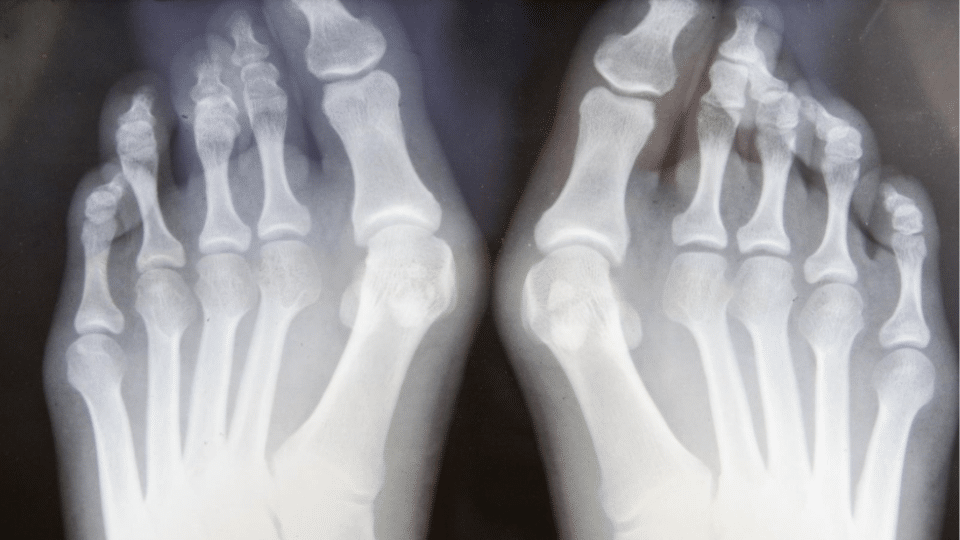A bunion often begins as a small, hard-to-ignore bump at the base of the big toe. Over time, it can become painful, make shoes uncomfortable, and limit mobility. While many people assume bunions are caused only by tight shoes or high heels, genetics may also play a significant role in whether they develop and how quickly they progress.
In this article, we’ll explain how inherited traits contribute to bunions, what additional factors can make them worse, and what you can do to slow their progression before surgery becomes necessary.
Are Bunions Genetic? The Family Connection
Bunions, also known as hallux valgus, occur when the joint at the base of the big toe shifts out of alignment, creating a visible bump on the side of the foot. Research shows that bunions often appear in multiple generations of the same family. This means that if your parents or grandparents had bunions, you may be more likely to develop them too.
The genetic link isn’t about inheriting the bunion itself, but rather the foot structure that makes bunions more likely to form. For example:
- Flat feet or fallen arches can increase stress on the big toe joint. If you’d like to understand this condition in more detail, read our full guide on flat feet here.
- Loose ligaments may allow bones to shift more easily.
- Abnormal bone structure (such as a long first metatarsal) can make the joint unstable.
These inherited traits create the perfect environment for bunions to form over time.

Other Risk Factors Beyond Genetics
Even if bunions are genetic, lifestyle and environmental factors can make them worse:
- Footwear choices: Shoes that are too narrow or high-heeled crowd the toes and accelerate bunion formation. Explore our guide to choosing the right shoes.
- Repetitive stress: Jobs or activities that place extra pressure on the feet can aggravate bunions.
- Arthritis: Joint inflammation can make bunions more painful and progress faster.
- Age and gender: Bunions are more common in women and often appear with age as ligaments weaken.
Understanding that bunions are influenced by both genetics and lifestyle helps patients take a proactive approach to foot health.
Signs You May Be Developing a Bunion
If bunions are genetic in your family, it’s important to monitor your feet for early warning signs:
- A visible bump on the side of the big toe.
- Redness, swelling, or soreness around the joint.
- Difficulty finding comfortable shoes.
- Pain when walking or standing for long periods.
- Big toe leaning inward toward the other toes.
Bunions can also cause discomfort in other areas of the foot as your walking pattern changes. To learn more about how bunions impact overall foot health, read our article here. Catching them early gives you more treatment options and may delay the need for surgery.
What You Can Do to Prevent or Slow Bunion Progression
The fact that bunions are genetic doesn’t mean they are unavoidable. By making smart choices, you can reduce discomfort and slow their development:
- Choose supportive footwear with wide toe boxes and low heels.
- Use custom orthotics to correct foot mechanics and relieve pressure. Learn how orthotics support comfort and mobility.
- Lighten the strain on your joints by staying active and balanced.
- Stretch and strengthen your feet with targeted exercises.
- Seek podiatric care early to monitor changes and get personalized recommendations.
Acting now can help you stay comfortable and active, even if bunions run in your family.
When to See a Podiatrist
So, are bunions genetic? In many cases, yes. But genetics are just one piece of the puzzle. The shoes you wear, the activities you do, and how you care for your feet all play a role in whether bunions develop and how severe they become. By understanding your inherited risk and taking proactive steps, you can protect your foot health and maintain your mobility for years to come.
If you notice bunion symptoms that interfere with your daily life, it’s time to see a foot specialist. If you’re starting to notice pain, difficulty with shoes, or changes in your foot shape, a podiatrist can help you explore the right solutions. For a deeper look at the treatment options available, read our bunion treatment guide.
If bunions are affecting your comfort or mobility, don’t wait until the pain gets worse. The team at Fall Creek Foot & Ankle is here to help with personalized care and treatment options designed around your needs. Schedule an appointment today! The earlier you seek care, the more likely it is that you can manage bunions.
